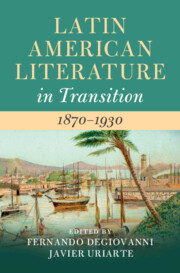Book contents
- Latin American Literature in Transition 1870–1930
- Latin American Literature in Transition
- Latin American Literature in Transition 1870–1930
- Copyright page
- Contents
- Figures
- Contributors
- Acknowledgments
- Introduction
- Part I Commodities
- Chapter 1 Rubber
- Chapter 2 Guano and Nitrates
- Chapter 3 Coffee
- Chapter 4 Plantains and Bananas
- Chapter 5 Sugar
- Chapter 6 Yerba
- Part II Networks
- Part III Uprisings
- Part IV Connectors
- Part V Cities
- Index
- References
Chapter 4 - Plantains and Bananas
from Part I - Commodities
Published online by Cambridge University Press: 14 January 2023
- Latin American Literature in Transition 1870–1930
- Latin American Literature in Transition
- Latin American Literature in Transition 1870–1930
- Copyright page
- Contents
- Figures
- Contributors
- Acknowledgments
- Introduction
- Part I Commodities
- Chapter 1 Rubber
- Chapter 2 Guano and Nitrates
- Chapter 3 Coffee
- Chapter 4 Plantains and Bananas
- Chapter 5 Sugar
- Chapter 6 Yerba
- Part II Networks
- Part III Uprisings
- Part IV Connectors
- Part V Cities
- Index
- References
Summary
This chapter will examine the representation of labor in Latin American texts relating to the cultivation, distribution, and consumption of two hybrid species of the Musa paradisiaca, the sweet banana and the starchier plantain in late nineteenth and early twentieth century. In a span of seventy years, bananas would go from being represented as fruit of independence to fruit of horror, attesting to the violence embedded in the transition from local farming to the industrial plantation. Unlike the sweet banana – which would be at the center of these transitions – the starchier plantain would remain offstage in this global industry. The differences in the representation of bananas and plantains respond to changes in their production and show us how representation of a fruit depends on how capital makes it work (or not) for its own profit.
Keywords
- Type
- Chapter
- Information
- Latin American Literature in Transition 1870–1930 , pp. 59 - 73Publisher: Cambridge University PressPrint publication year: 2022

